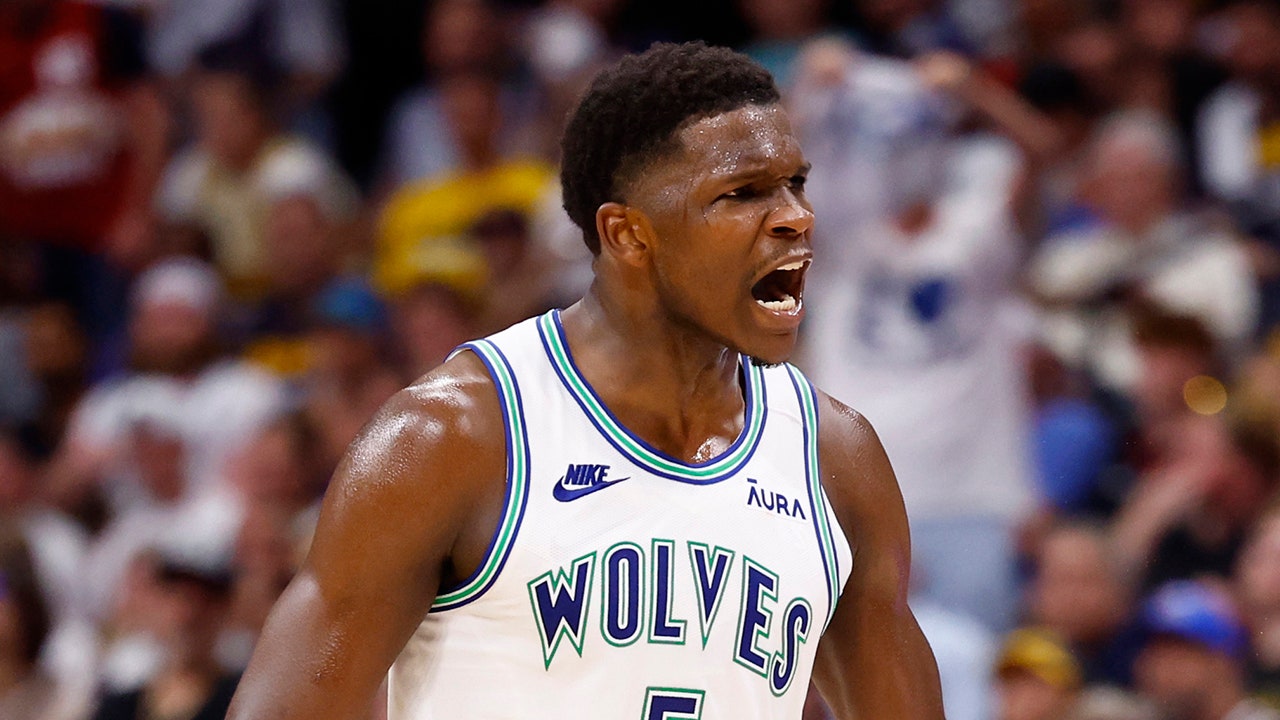Lifestyle
This Storybook cottage's native plant wonderland shows how gorgeous no grass can be

Water-hungry lawns are symbols of Los Angeles’ past. In this series, we spotlight yards with alternative, low-water landscaping built for the future.
Once upon a time, under Universal Studios’ watchful Minion eye, there was a Storybook house in Studio City with a steep, sagging roof, a towering, tottering chimney and a yard so boring and prone to flooding that its charm was pretty much negated.
The front yard was mostly dead grass; the driveway was cracked and broken from runoff whenever it rained; and the funnel-shaped backyard was overwhelmed by a rotting wood pergola.
Succulents in the front yard grow in an alcove built into the chimney.

A planter spills over with succulents in Michael Solberg and Khoi Pham’s home garden.
No longer. Today, the yard of Khoi Pham and his fiancé, Michael Solberg, is a wonderland of native plants, water-conserving bioswales, a patio mosaic made from recycled concrete and permeable gravel paths with a delightful crunch. And throughout the garden are little riots of succulents spilling from pots, baskets and even the fanciful nook built into their chimney, dotting the garden with jolts of color like fancy embellishments on a cake.
There are lots of little signs identifying the plants too, to feed Solberg’s vision of educating passersby about the beauty, practicality and sustainability of native plant landscapes. The signs “make you feel like you should stop and pay attention,” said Solberg.
But they’re also helpful because this yard, designed and built by landscape designer Isara Ongwiseth of FormLA Landscaping, is one of three featured gardens during the Garden Conservancy’s San Fernando Valley Open Days Garden Tour on April 28, and the only one featuring a landscape devoted to California native plants. (Tickets are $10 per garden.)
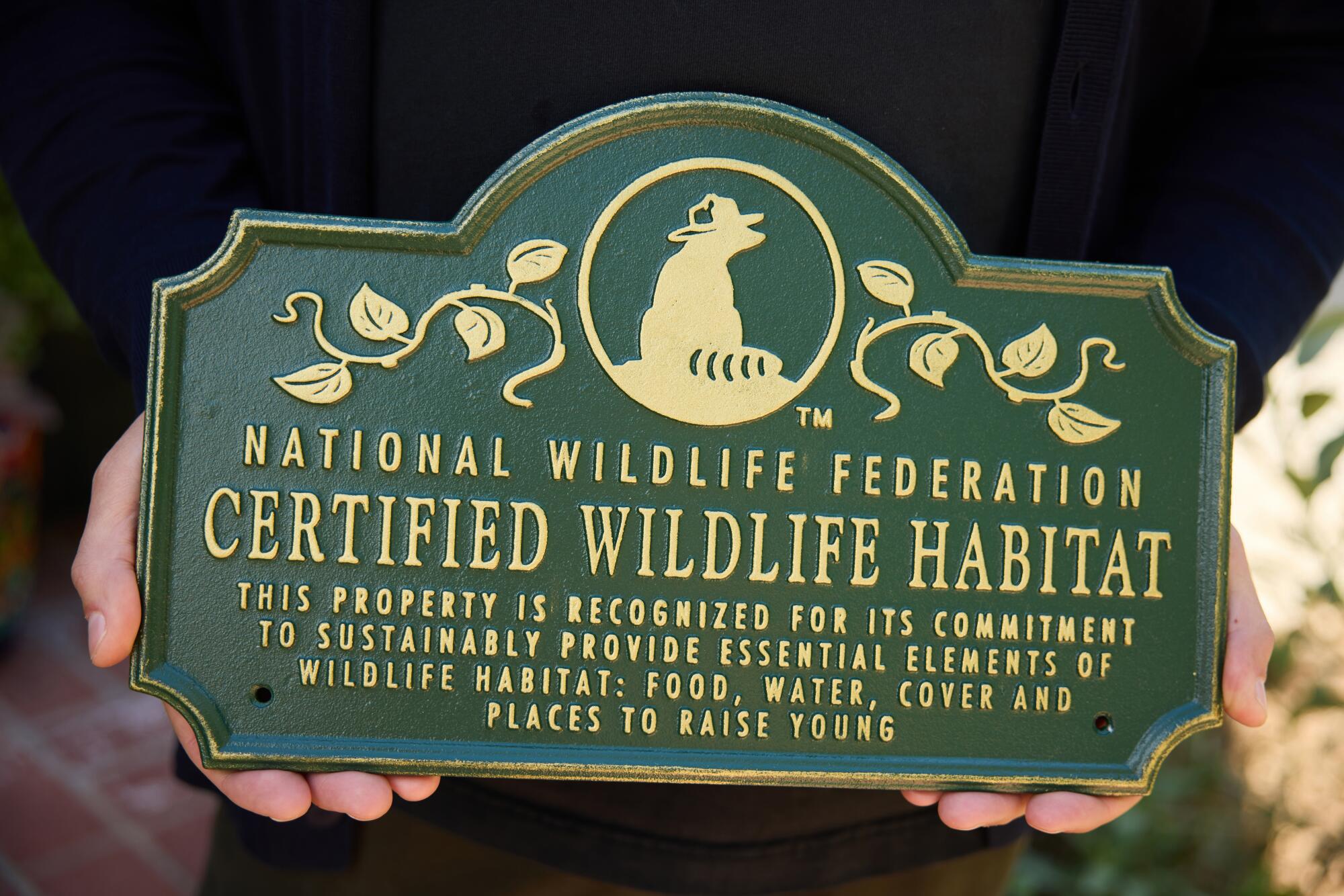
FormLA Landscaping provided this plaque for Michael Solberg and Khoi Pham’s native plant landscape.
(Yuri Hasegawa / For The Times)
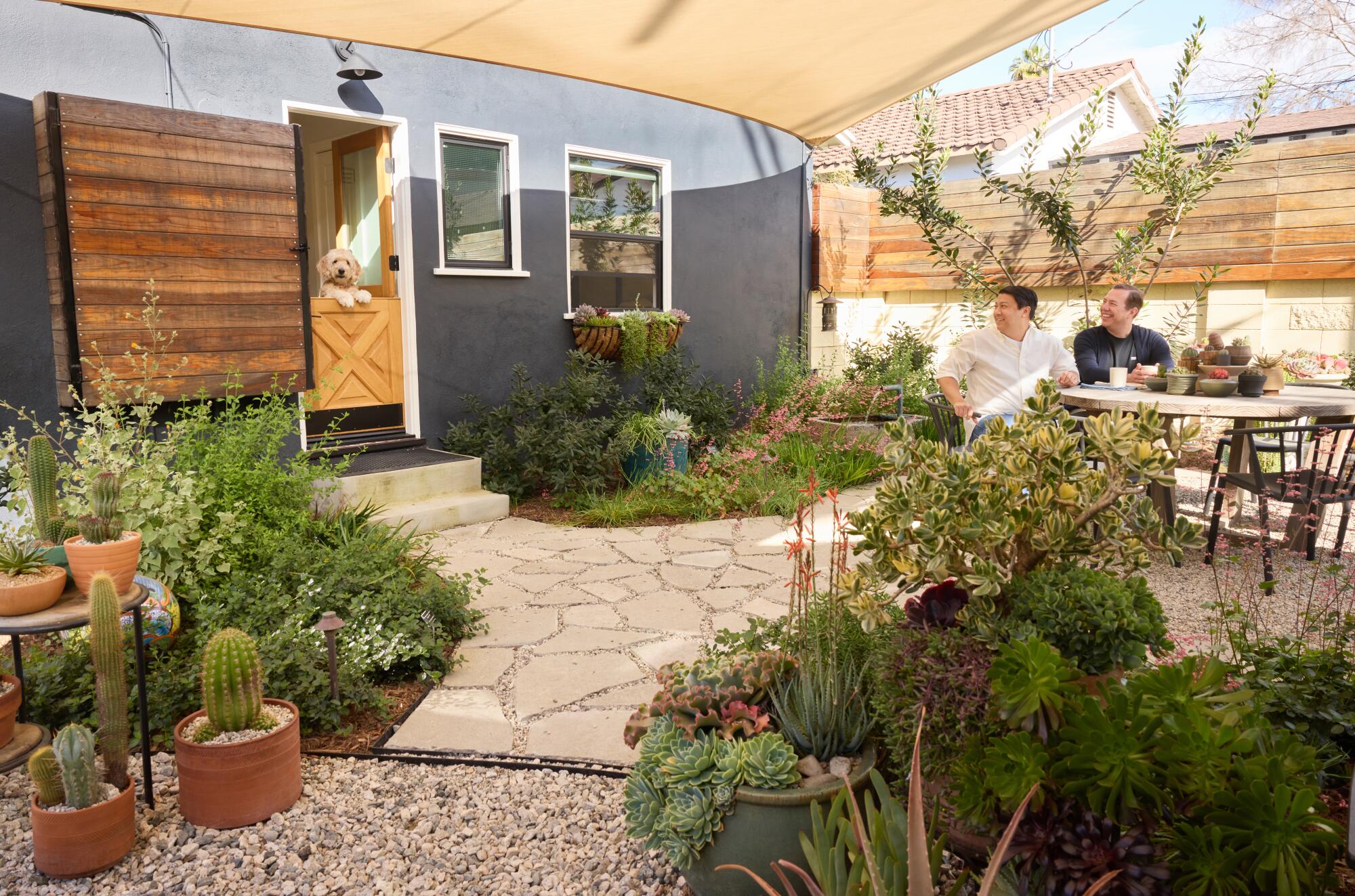
Native shrubs and flowers fill the shaded backyard’s planting areas, which are edged by pots and baskets brimming over with succulents and cactus, but all Lucy the goldendoodle wants is to join her owners outside.
(Yuri Hasegawa / For The Times)
The landscape is lush for one so young — it was installed in February 2022 — and features multiple plantings of a few varieties of native plants, such as the red-berried toyon, which Solberg is trying to espalier along one wall of his garage, dark-green ceanothus shrubs mingling with the silvery leaves of white sage (Salvia apiana), rings of Douglas iris (Iris douglasiana), earth-bound wisps of blushing coral bells, a.k.a. Wendy alumroot (Heuchera ‘Wendy’) and two Western redbud trees (Cercis occidentalis) — one in front, one in back — that bloom in deep violet clouds each spring.
For the record:
9:24 a.m. April 15, 2024An earlier version of this article incorrectly stated that the landscape was installed in February 2021. It was installed in February 2022. A photo caption incorrectly said the house is in North Hollywood. It is located in Studio City.
Out front are islands of fragrance that bloom in varying shades of purple — coyote mint (Monardella villosa), Cleveland sage (Salvia clevelandii) and bee’s bliss sage (Salvia ‘Bee’s Bliss’), along with clumps of deer grass (Muhlenbergia rigens), Oregon grape (Mahonia aquifolium) and the deep-throated flowers of Margarita BOP penstemon (Penstemon heterophyllus ‘Margarita BOP’).
Basically, Solberg said, except for the creeping fig lacing the chimney and the giant camphor tree on the parkway in front, any plants in the ground of their new landscape are California native plants; others, like his succulents and dwarf lemon, are planted in pots. And he hopes their plantings encourage more of the same.
I wanted to get the word out that native plants are a great way to have a sustainable garden that doesn’t require too much water, is good for wildlife and insects, is easy to care for and looks great too.
— Michael Solberg
“You just don’t see a bunch of California native gardens in our neighborhoods. What you see is lawn and standard shrubs, or fake turf or people who just paved everything over,” Solberg said. “I wanted something unique and different for our landscape, but also responsible with water and nature, and education was a really big part of that. I wanted to get the word out that native plants are a great way to have a sustainable garden that doesn’t require too much water, is good for wildlife and insects, is easy to care for and looks great too.”
This was Solberg and Pham’s second foray into creating a native plant landscape. Before they bought their Storybook home in late 2019, they’d taken out the lawn in front of their former home in Sherman Oaks and, inspired by gardens they’d seen on the Theodore Payne Foundation’s Native Plant Garden Tours, decided on a water-conscious landscape that relied on native plants instead of cactus and drought-tolerant plants from other countries with Mediterranean climates.
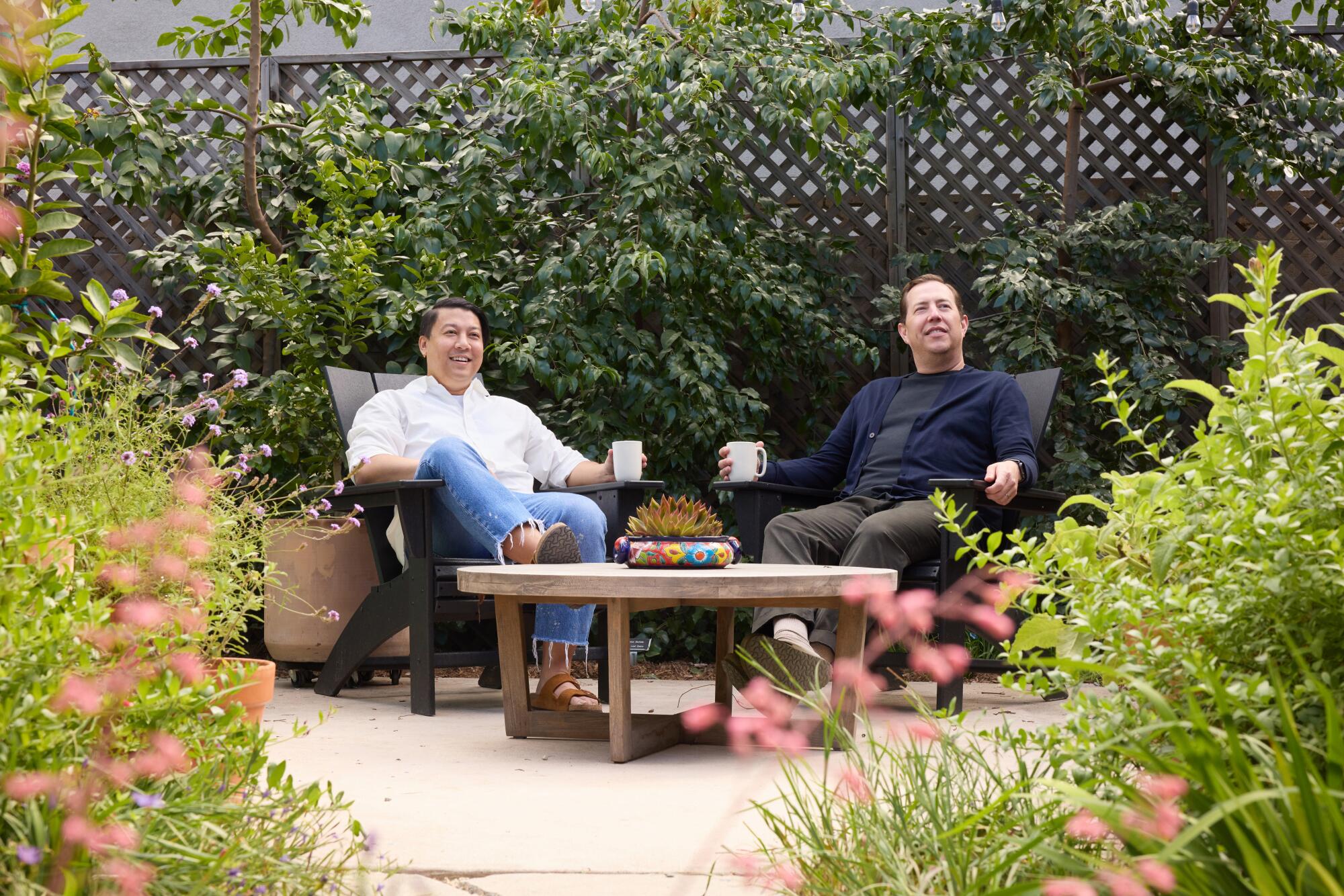
Khoi Pham, left and Michael Solberg enjoy sitting in their backyard garden most mornings, sipping coffee and admiring the leafy view.
Solberg — the gardener of the family — said he learned a lot in that DIY project: what native plants grow quickly and slowly, which he liked the best and which ones he should have placed somewhere else (such as a Matilija poppy that rapidly outgrew its location).
When it came time to finally landscape their new home in Studio City, Solberg said he wanted to continue the same theme, but he was concerned about dealing with the property’s special problems — a small, weirdly shaped backyard dominated by an aging pergola and water that ran off their Hansel-and-Gretel roof in sheets, creating runoff and flooding.
So in addition to an all-native-plant landscape, Solberg wanted permeable surfaces that would trap water in the soil instead of sending it out into the street — but he didn’t want any gutters to ruin their roof’s unusual lines. He wanted gravel walkways and drives that wouldn’t require constant maintenance. He wanted year-round color and interest, shade and privacy from the tall apartment building behind their house and plants that would attract birds and other pollinators.
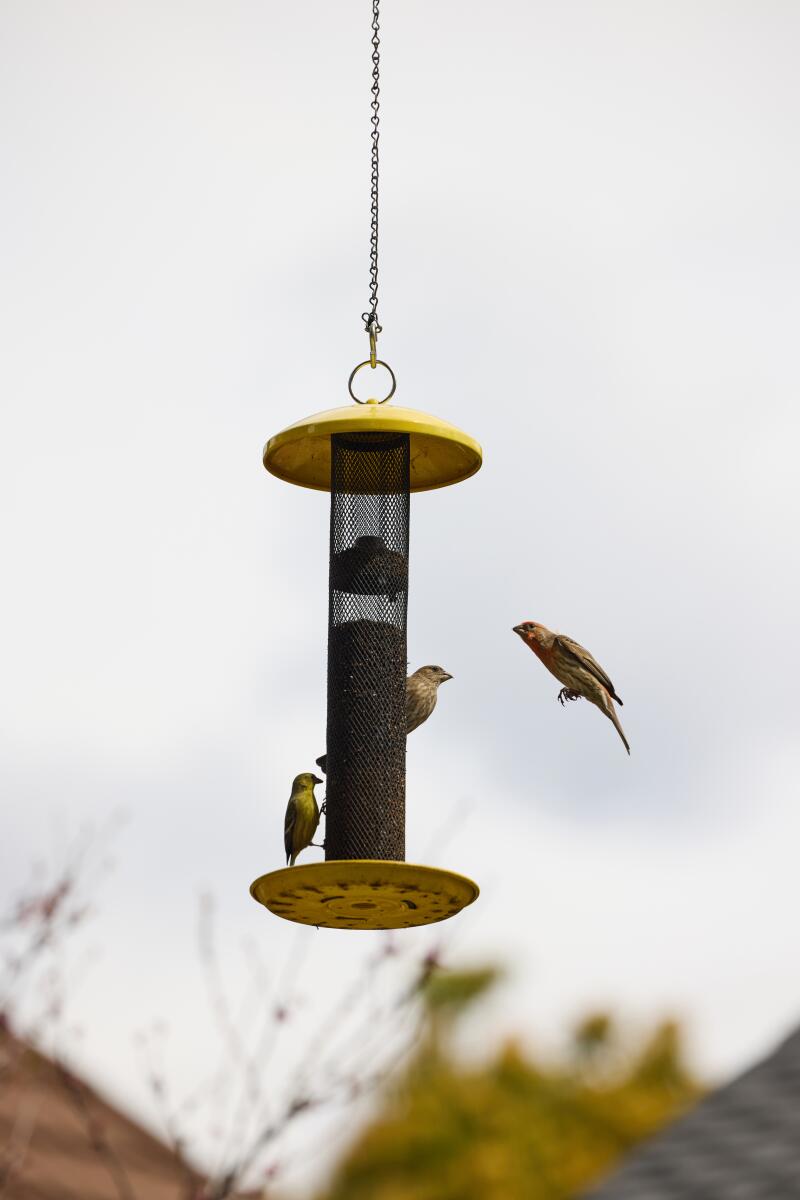
Birds fly around a feeder in Michael Solberg and Khoi Pham’s front yard.

A bee noses among the pink blooms of a spray of coral bells.
They also had lifestyle considerations: Both men work from home — Solberg full-time overseeing corporate retail operations for a chain of tool stores and Pham at least two days a week as a research and development scientist for medical devices such as hospital sterilization equipment — so creating a serene and cheerful work environment was crucial inside and out.
And then there were Pham’s concerns. He was happy to leave the plant decisions to Solberg, the green thumb of the family. “I do the budget, but when it comes to gardening, I’m more of a cheerleader,” Pham said. “I was thinking more about the parties I’m going to throw in the backyard, and how they have to flow a certain way.”
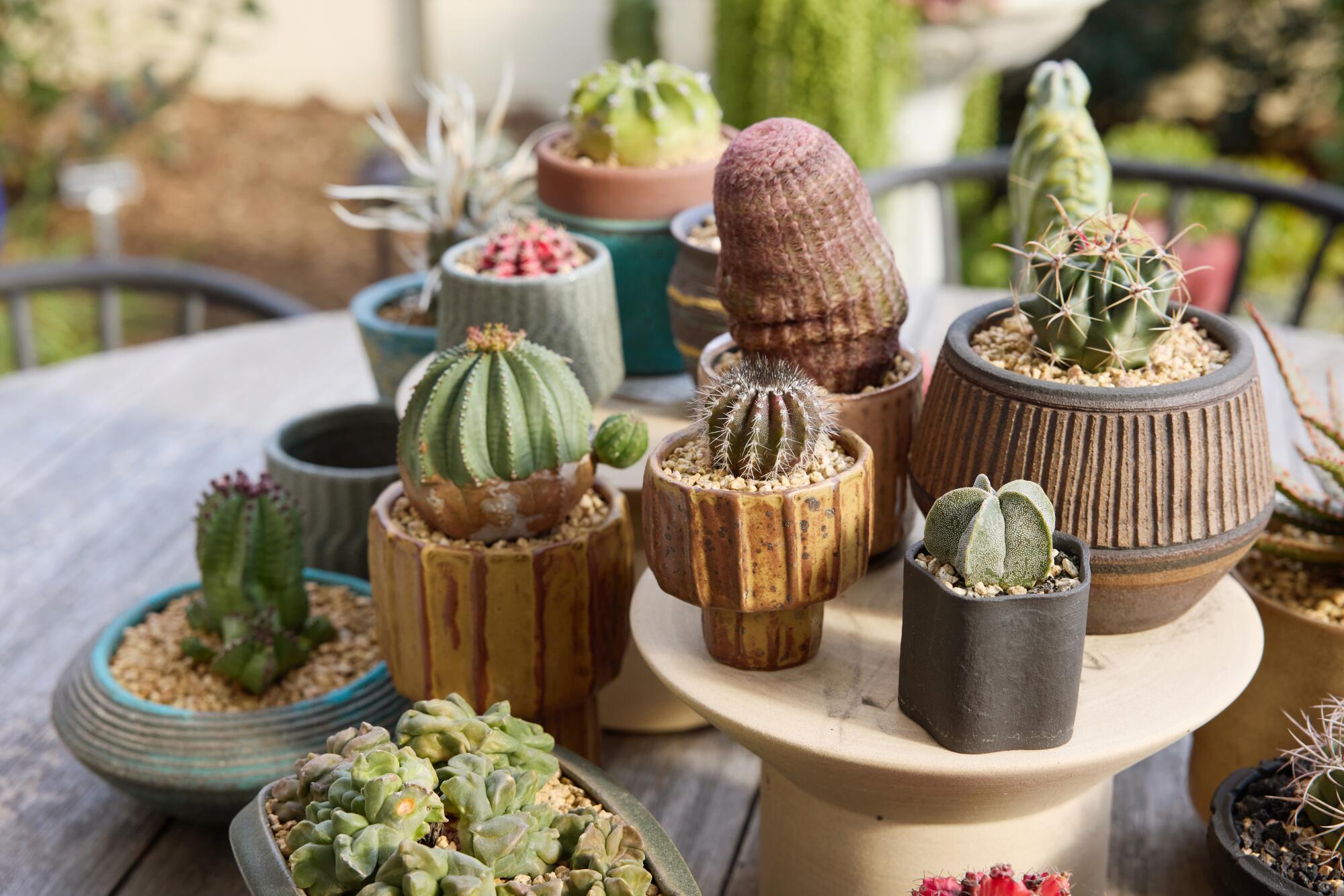
Part of Michael Solberg’s artful cactus collection sits clustered on a circular table in the home garden.
Solberg grew up around plants and gardening, but Pham said they were never a part of his life until the two met in San Diego in 2011. “When we first met, he had a beautiful succulent garden on his tiny patio that was really impressive — I had plastic succulents I bought from Crate & Barrel,” Pham said, laughing. “I just dusted them every once in a while.”
So there were lots of things to consider in creating their new landscape, Solberg said, plus he already knew how much work it was to take out a lawn and create a new landscape. So in the end, they called FormLA Landscaping, because they had admired the firm’s native landscapes in the past, and began laying out their wish list to Ongwiseth, the lead designer.
It took a few tweaks and persuasion — and $60,000 — but in the end, Solberg and Pham said Ongwiseth made their vision better than they had dreamed.
But there were a few bumps along the way.
One of the first decisions was removing the raised wooden deck in the backyard, Ongwiseth said. Pham and Solberg were reluctant not to rebuild, until they saw how much space the removal created. “It put everything at ground level, so you feel like you’re part of the garden instead of above it,” Solberg said.
Solberg was adamant about not wanting gutters to clutter up the roof line. Ongwiseth used French drains around the house perimeter — basically a trench filled with gravel and a perforated pipe to capture the runoff and direct it to the bioswales in the front yard. Ongwiseth finally convinced Solberg to add a small section of gutters on the south side of the house, along the driveway, where they were nearly invisible.
The two bioswales in the front are like planted indentations in the ground that fill with water after a heavy rain and hold it long enough that it sinks in. The gutters help direct rainfall into pipes that drain into the swales. Once they removed the broken concrete driveway and replaced it with ¾-inch crushed angular gravel, they found the rocks helped trap water coming off the roof as well, so that it sunk into the ground instead of pooling and flooding in spots like the old driveway. They also installed a subterranean drip irrigation system, which automatically waters two days a week for 10 minutes. The system uses sensors to skip watering days if it’s raining.
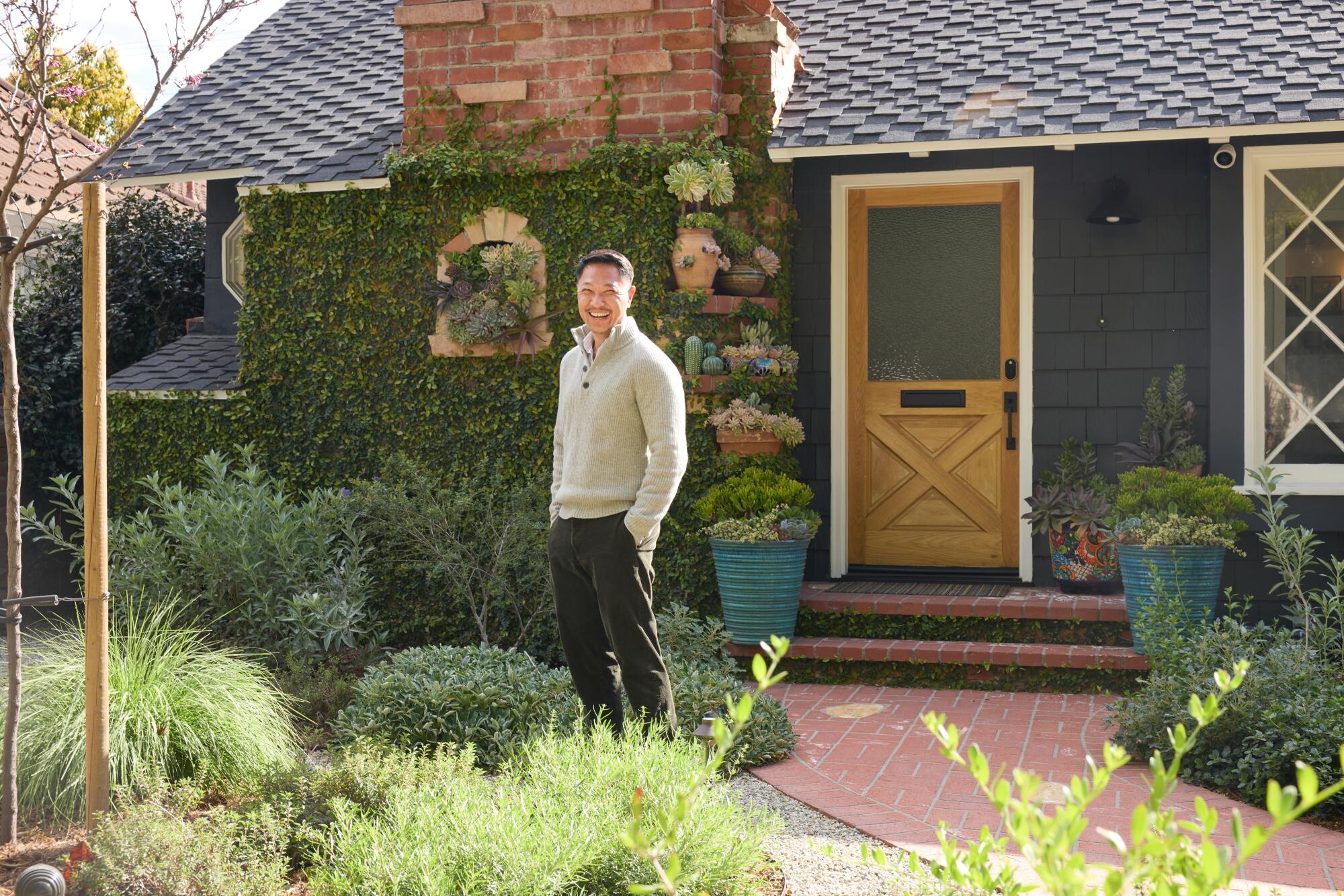
FormLA Landscaping lead designer Isara Ongwiseth in the front yard he designed.
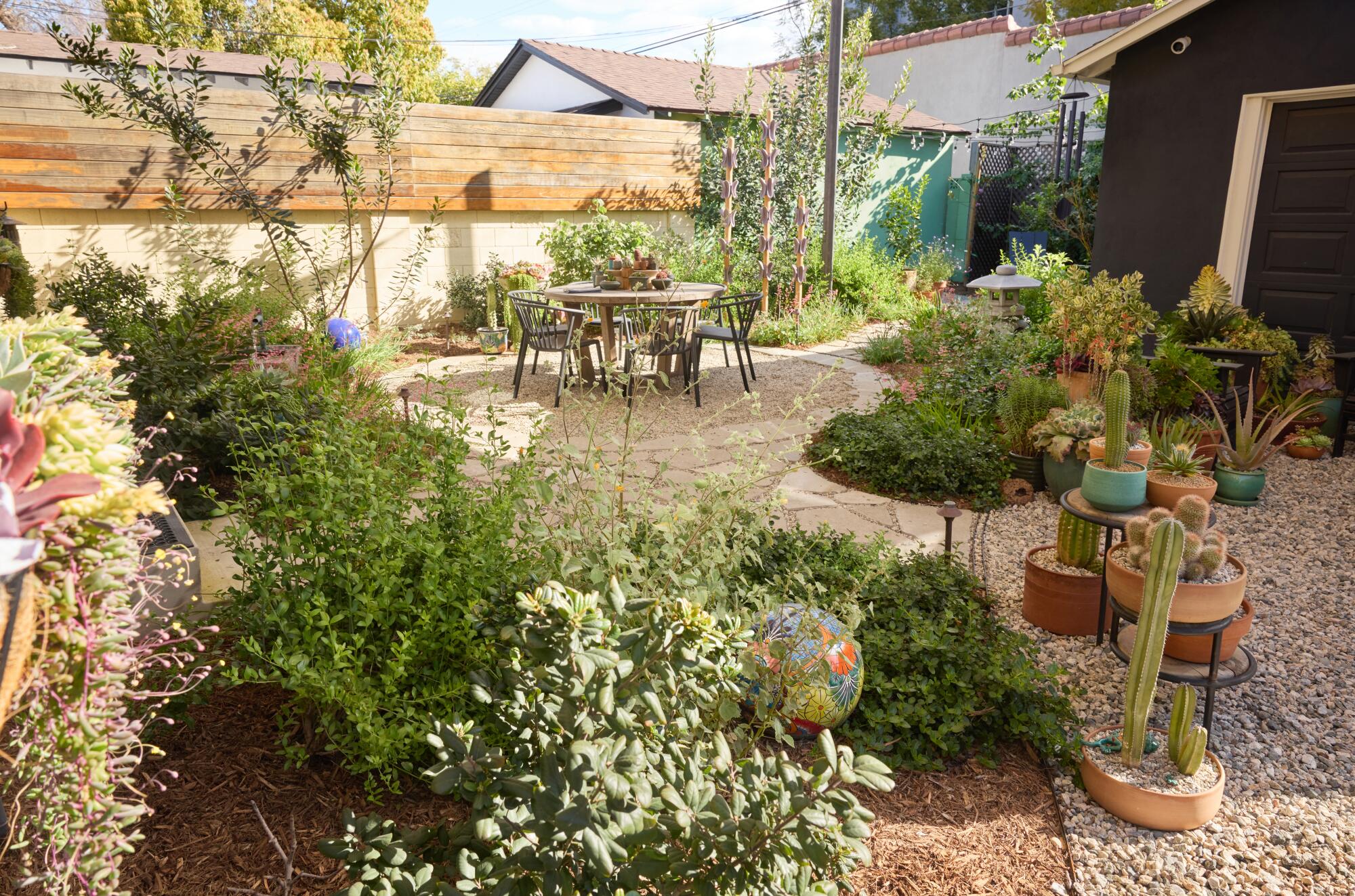
The backyard includes a circular gravel patio and meandering paths, edged in broken concrete.
The swales are edged with meandering paths of smaller, 3/8-inch angular gravel, and mostly hidden by the plants. Gravel was high on Solberg’s wish list, partly for sentimental reasons. His grandmother had gravel paths, he said, and he always loved the way they crunched when he walked on them. There’s a security aspect too, Ongwiseth said: “You’ll always know if somebody has wandered into your garden.”
But creating permeable paths and drives is more challenging than you’d think, Ongwiseth said. “Gravel and decomposed granite sounds good, but then you start tracking granite into the house and scratch the floor, so what do you do with that?” And round smooth gravel may look nice from afar, but your feet sink into those rocks when you walk on them, and they tend to scatter everywhere when children or dogs scramble by. (Pham and Solberg have two rambunctious dogs — Lucy, a goldendoodle, and Teddy, a terrier mix.) Because the kind of gravel Ongwiseth chose locks together, the small rocks stay in place when you walk on them, and your feet feel supported instead of sinking.
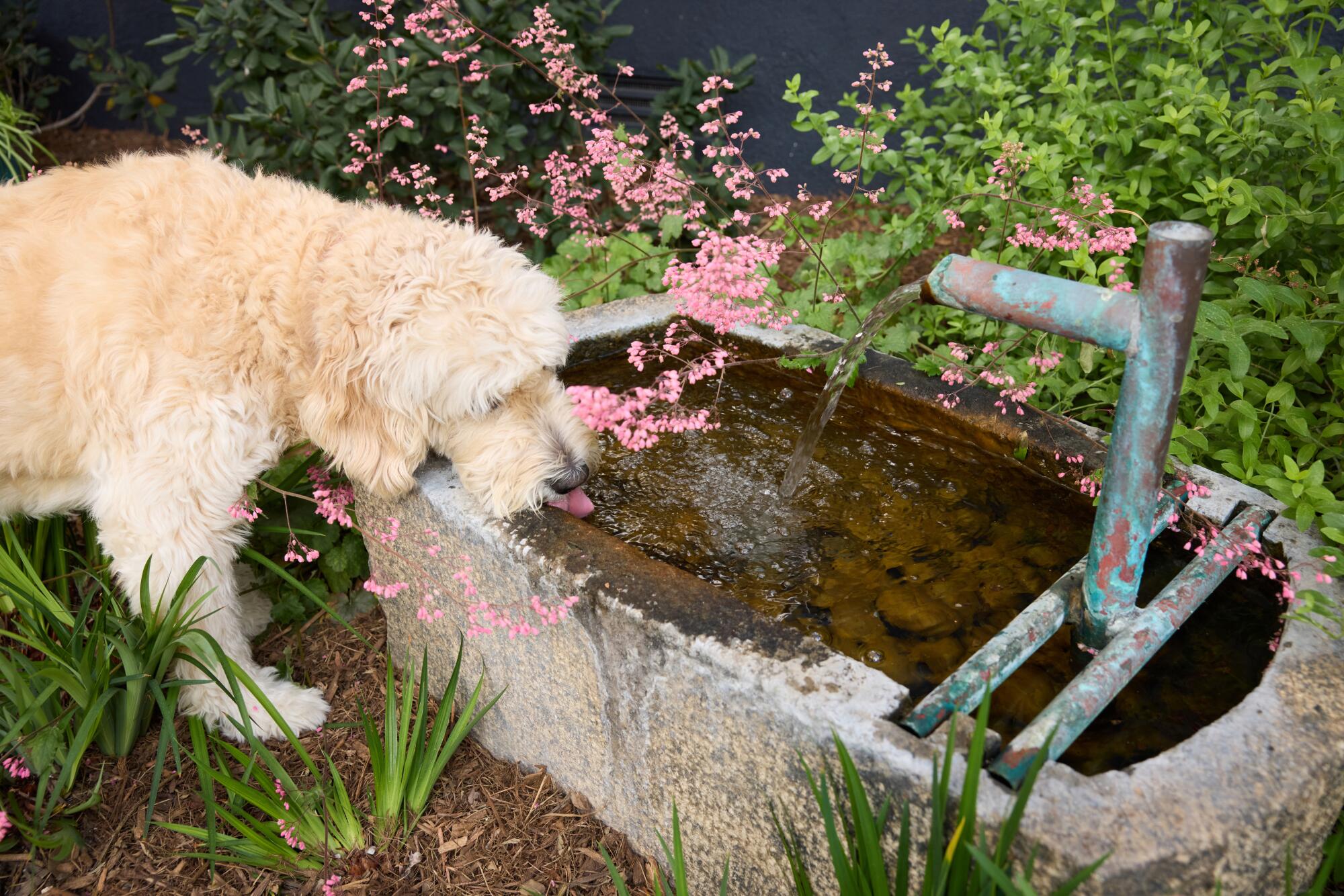
Lucy, Michael Solberg and Khoi Pham’s goldendoodle, laps at a rustic fountain next to a pink spray of coral bells.
Preparation was important too. After they tore out the old driveway and created the paths, they removed any weeds, added another drain at the end of the driveway and laid down a geo-textile fabric that suppresses weed growth while allowing water to soak through, before topping off the areas with two inches of gravel.
“Choosing the right type of weed barrier is very important, because so many will start to degrade over time,” Ongwiseth said. “The geo-textile fabrics don’t do that. I have many gardens I’ve installed in the last 15 years where the weed barrier is still holding up.”
Another point of concern was Ongwiseth’s plan to frame the gravel seating area outside the back door with a mosaic of broken concrete. “Broken concrete doesn’t sound very nice,” Pham said, “It felt a little too DIY, but once it was installed, I was like, ‘Oh, where else can we install it?’”
In fact, Pham said, you can still see a portion of rebar in one of his favorite pieces of concrete, “because it shows that it was reused. It truly is an art; they had to chip away at pieces of concrete to put the puzzle together to make it fit into the space.”
The finished design does look artistic, but it was all part of Ongwiseth’s practical considerations about transitioning between yard and home. He wanted a design that basically cleans your shoes of any dust or debris before you step inside. He grew up in a traditional Asian family where everyone takes off their shoes before they enter a home, “but not everyone practices that, so creating a landing or space even with concrete provides that transition.”
He also wanted to honor Solberg’s vision of having permeable surfaces throughout the garden, so instead of big concrete slabs there are spaces between all the small pieces of concrete to allow water to sink into the ground. Those spaces can create uneven places for chairs and tables, he said, so he made the main seating areas all gravel rimmed by the decorative pieces of concrete.
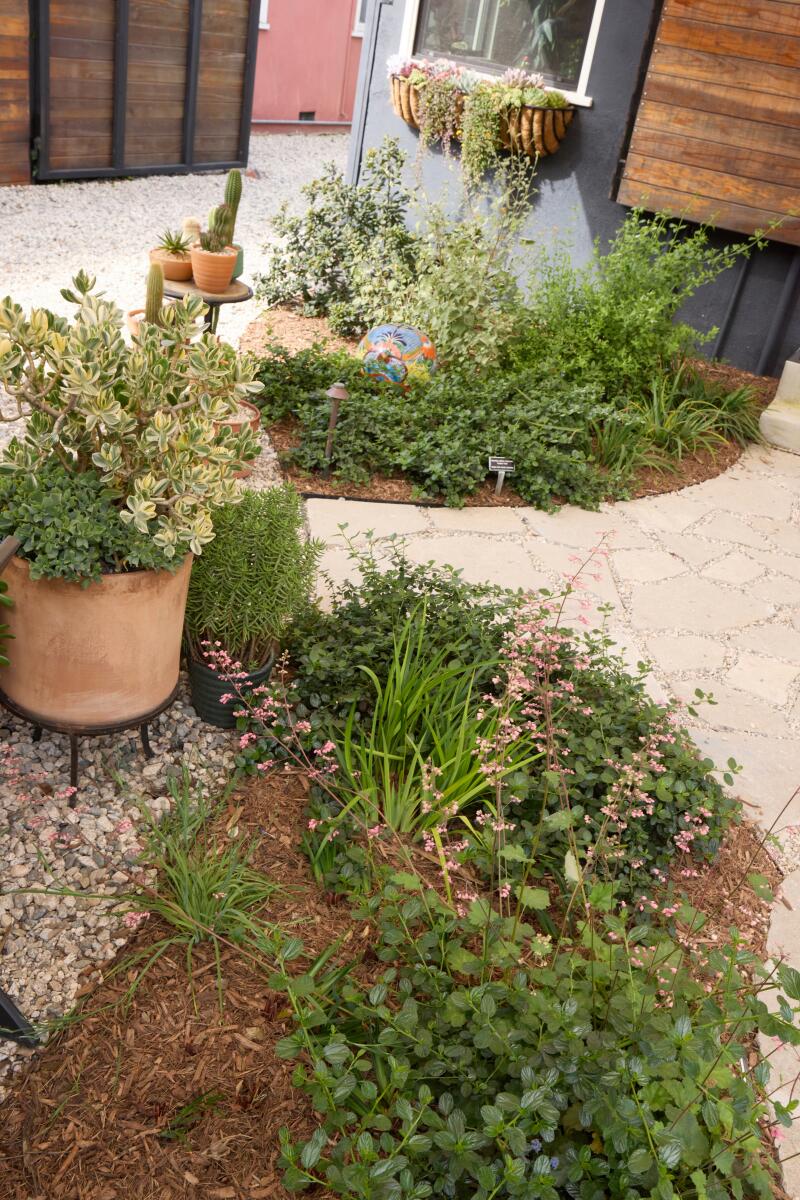
Broken concrete and gravel creates a walkway between planting areas and pots of succulents.

Michael Solberg’s pots of succulents add jolts of color around the home’s native plant landscape.
Ongwiseth also considered the fantastic Storybook design of the house in creating his design. As visitors will see, there is a sense of mystery and exploration as you walk from the front to the back.
“I wanted to create a meandering garden experience, where the whole garden is not revealed right away,” he said. “When we first arrived, we noticed the awkwardness of the shape of the backyard, and that old shade structure [the pergola] just emphasized that awkwardness. Once we removed all that we came up with a design that was more fluid, something that makes you want to explore the richness of the foliage, and the sense of many destinations throughout.”
There was a final and unexpected challenge, when Pham and Solberg were forced to remove a large camphor tree that provided privacy and filtered shade in their backyard. The tree had grown into their neighbor’s garage so it had to be removed, exposing their yard to the multistory apartment building behind them.
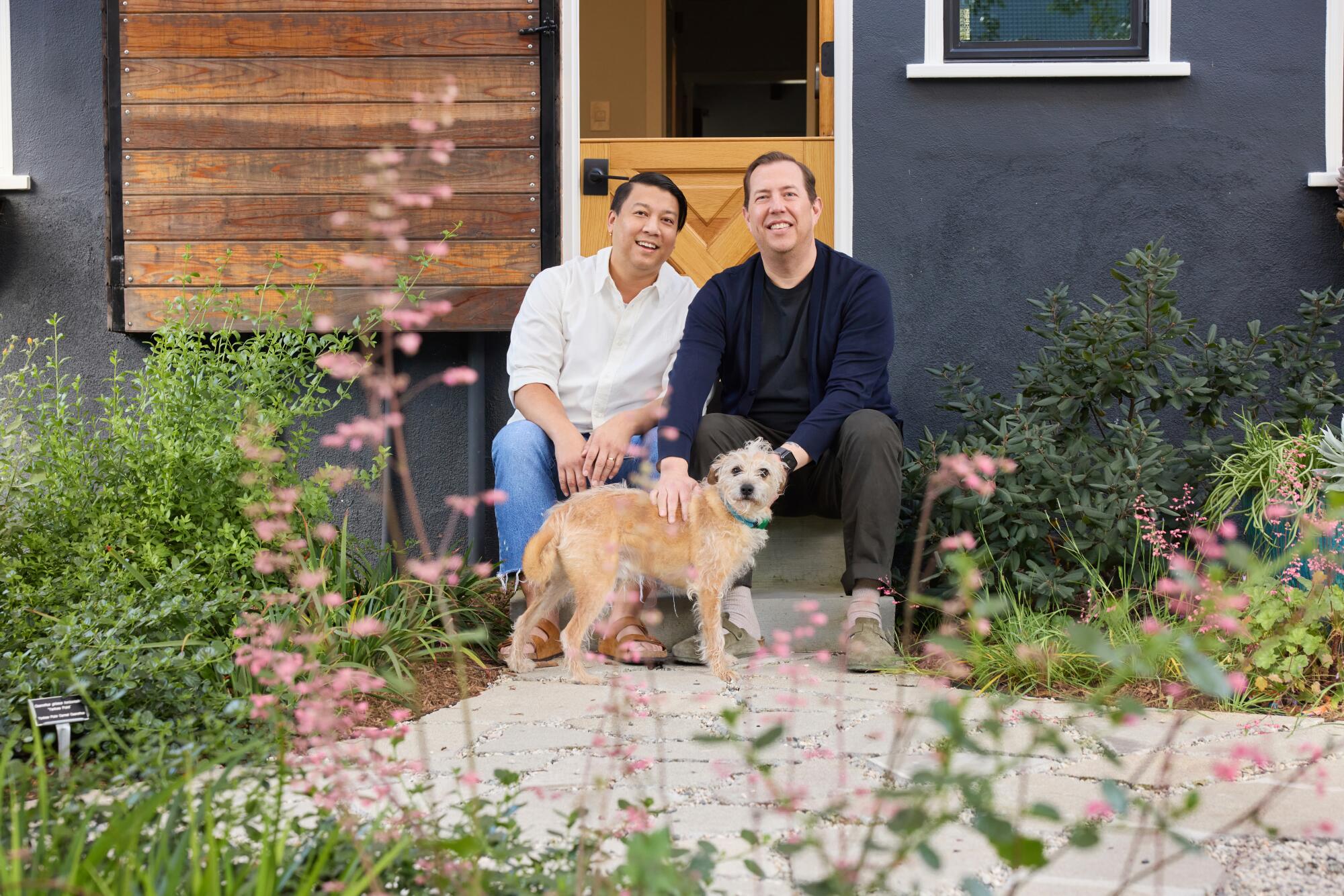
Khoi Pham, left, and Michael Solberg with their terrier mix, Teddy, one of their two dogs.
Ongwiseth softened the privacy issue by installing a large sail-shaped cover stretching from the house to the detached garage, which provides welcome shade during the summer but allows enough sunlight to filter through to keep the plants happy. They planted another redbud tree in the space where the camphor once stood — freeing up some additional space for their barbecue as well — and a bank of hollyleaf cherry (Prunus ilicifolia) at the very back that are already tall enough to block out a large swath of the apartments.
All in all, Pham and Solberg are still pinching themselves about how well it all came together. “There’s a healthy water table under our house now,” Solberg said, laughing. “And maintenance-wise, there’s not a lot we have to do. I have a blower to get rid of excess leaves once in a while, and sometimes, when it gets a little overgrown, I have to get out my clippers, but for the most part it tends to itself.”
These days, they can work outside at a large round table, with its small pots of colorful succulents, or drink coffee in the seating area nearby. Those places are separated by only a few steps, but they feel like a journey, admiring the tall abstract Dustin Gimbel sculptures of salvia whirls, next to real salvias blooming nearby, or the pots of blooming De La Mina verbena (Verbena lilacina ‘De La Mina’) and fragrant pitcher sage (Lepechinia fragrans).
This lovely space is where they’ll host their wedding reception in July, for about 50 people, the wide driveway functioning as a seating area as well as a way to drive in and out of their garage. Pham has his party flow, and Solberg has his vision of a landscape both beautiful and sustainable, visited by pollinators and birds.
“My advice is, just trust the process,” Solberg said. “Normally I would want more control, but I gave up creative license and learned a lot, like the Palmer’s Indian mallow (Abutilon palmeri) — I never would have chosen that for our garden because I didn’t know about it. So I learned, if you trust in the process, you can end up with something incredible, better than if you had done it on your own.”

Lifestyle
J Lo and Ben Affleck Do Sunday Funday Together Despite Living Apart
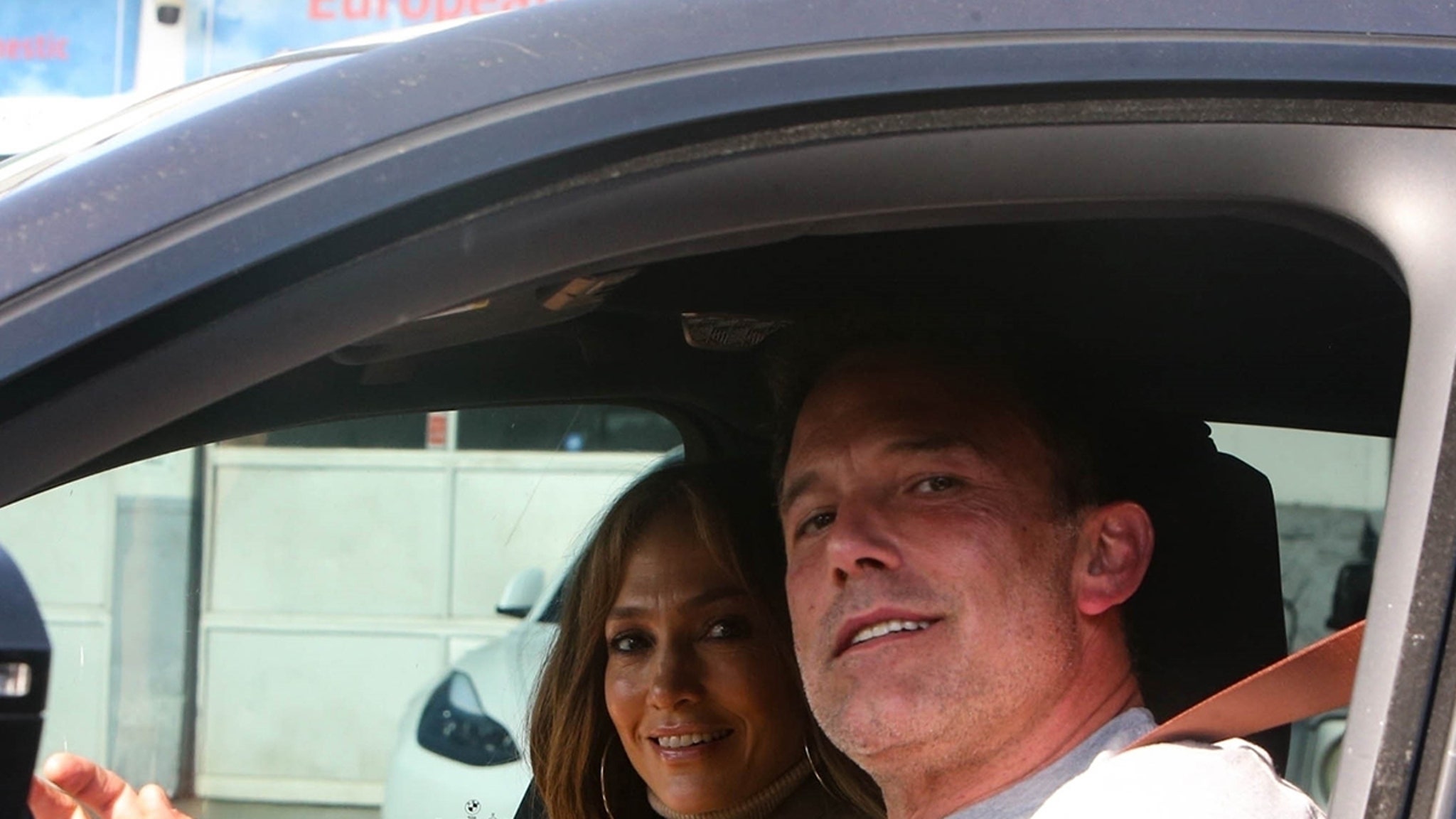
Jennifer Lopez and Ben Affleck seem to be saying they’re all good, maritally speaking — even though they’re not living under the same roof, they spent much of Sunday together … looking like a happy couple.
The apparently estranged couple met up Sunday in Santa Monica, where they both showed out to support J Lo’s kid, Emme, in a school event. Jen Garner also showed up with Fin, as Ben and Jen’s kid is pretty tight with Emme.
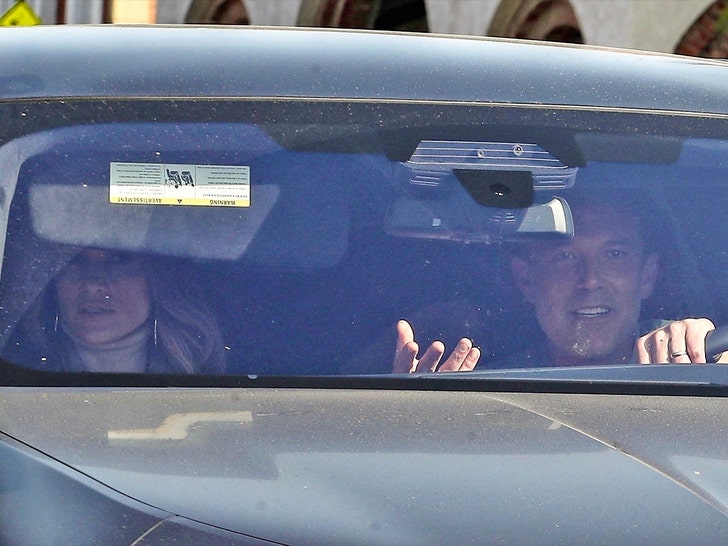
Anyway, things got more interesting when they left Santa Monica — Ben was smiling behind the wheel, and Jennifer was in his passenger seat, as they headed out … apparently to grab dinner together at BOA Steakhouse in WeHo.
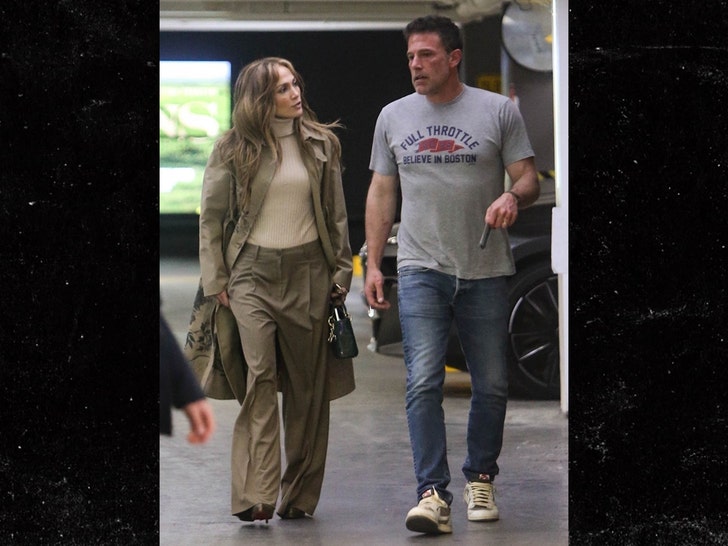
Of course, they were photographed as they left dinner, too … which is not shocking. BOA is one of the L.A. restaurants where all celebs know the paps are gonna take their photo.
If Jen and Ben really wanted alone time, they could’ve stayed at BOA in Santa Monica — same menu, but way less attention.
As we’ve reported … Ben has been living in Brentwood in a home he’s renting, while Jennifer continues living in the $60 million Bev Hills mansion they bought together.
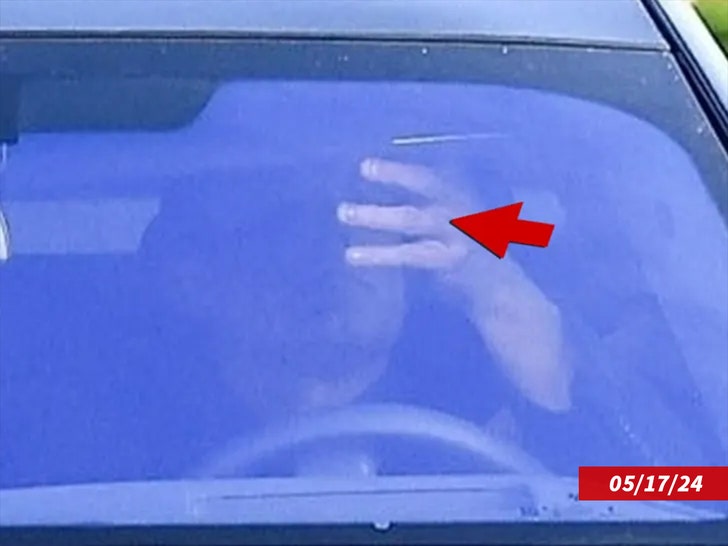
We also told you that Ben did not wear his wedding ring during a Friday outing, but he had it back on come Saturday outside his rental home.
Whatever happened before BA moved out, he and J Lo seemed to put it all on the back burner Sunday. Whether that prompts them to move back in together … 🤷🏽♂️
Lifestyle
Sean Combs apologizes for 'my actions in that video' that appeared to show an assault

Sean “Diddy” Combs is pictured at the CBS Radford Studio Center in 2018 in Los Angeles. On Sunday, Combs apologized for his actions in a video that appears to show him beating his former singing protege and girlfriend Cassie Ventura in a Los Angeles hotel in 2016.
Willy Sanjuan/Invision/AP
hide caption
toggle caption
Willy Sanjuan/Invision/AP

Sean “Diddy” Combs is pictured at the CBS Radford Studio Center in 2018 in Los Angeles. On Sunday, Combs apologized for his actions in a video that appears to show him beating his former singing protege and girlfriend Cassie Ventura in a Los Angeles hotel in 2016.
Willy Sanjuan/Invision/AP
Hip-hop mogul Sean “Diddy” Combs issued an apology on Sunday, two days after the release of a video which appeared to show him beating then-girlfriend Cassie Ventura.
“It’s so difficult to reflect on the darkest times in your life, but sometimes you got to do that,” Combs says in a video posted to Instagram. “I was f—– up — I mean, I hit rock bottom — but I make no excuses.”
The video, which was obtained and published by CNN on Friday, allegedly shows Combs grabbing, throwing, kicking and dragging Ventura in a hotel hallway, and throwing an object at her.
CNN reported that the video was recorded at the now-closed InterContinental Hotel in Century City on March 5, 2016. Elements of it appear to match accusations of physical and sexual assault that Ventura made in a civil lawsuit she filed against Combs last year.
While NPR has not been able to verify the authenticity of the video, in his apology, Combs appeared to do so.
“I take full responsibility for my actions in that video,” Combs said. “I was disgusted then when I did it. I’m disgusted now. I went and I sought out professional help. I got into going to therapy, going to rehab. I had to ask God for his mercy and grace. I’m so sorry. But I’m committed to be a better man each and every day. I’m not asking for forgiveness. I’m truly sorry.”

Ventura reached a settlement with Combs for an undisclosed figure in November, one day after the lawsuit was filed.
After the settlement, one of Combs’ lawyers, Ben Brafman, issued a statement declaring Combs’ innocence. He told NPR: “Just so we’re clear, a decision to settle a lawsuit, especially in 2023, is in no way an admission of wrongdoing. Mr. Combs’ decision to settle the lawsuit does not in any way undermine his flat-out denial of the claims. He is happy they got to a mutual settlement and wishes Ms. Ventura the best.”
NPR’s request for comment from Combs’ attorney on Sunday was not immediately returned.
In a written statement provided to NPR on Friday afternoon, Ventura’s attorney, Douglas Wigdor, said: “The gut-wrenching video has only further confirmed the disturbing and predatory behavior of Mr. Combs. Words cannot express the courage and fortitude that Ms. Ventura has shown in coming forward to bring this to light.”
Wigdor did not immediately reply on Sunday to a request for comment on Combs’ Instagram post.

Combs faces several lawsuits from named and unnamed plaintiffs alleging assault, rape and other misconduct. In March, federal agents raided homes associated with Combs in Los Angeles and Miami in what authorities at the time referred to as “an ongoing investigation.”
On Saturday, the Los Angeles County District Attorney’s Office said it was aware of the video and while it found the images “extremely disturbing and difficult to watch,” if the incident occurred in 2016, “unfortunately we would be unable to charge as the conduct would have occurred beyond the timeline where a crime of assault can be prosecuted.”
The statement said that law enforcement has not presented a case against Combs for the attack depicted in the video, “but we encourage anyone who has been a victim or witness to a crime to report it to law enforcement or reach out to our office for support from our Bureau of Victims Services.”
NPR’s Anastasia Tsioulcas contributed to this report.
Lifestyle
Renting used to be a source of shame to this apartment manager’s daughter. Now it’s a knowing comfort

I can barely remember a time when we didn’t live where we worked. Our first property manager job was for a 30-unit apartment building between Beverly Hills and Pico-Robertson. My parents didn’t speak English but got the job anyway because they knew a guy who knew a guy who knew a guy. There was an elementary school at the end of our magnolia tree-lined street that I couldn’t go to because the Beverly Hills School District allowed only Beverly Hills addresses. I would walk down the block to visit my friend (another apartment manager’s daughter) or to buy a sleeve of blue raspberry sour straws at the Blockbuster around the corner and hear children playing in the well-manicured school yard, but I never once saw an actual child. This was how I learned to perceive wealth in Los Angeles: near, but just out of reach.
Even at the age of 6 or 7 or 8, I knew that this was all temporary. Renting is inherently provisional, especially when you’re not actually paying rent. I made the most of it. While my mother cobbled together a career as a bookkeeper and my father assumed the role of both the maintenance guy and the manager of the building, I stole CDs from the mailroom, Rollerbladed in the slick oil-stained subterranean parking garage and belted Spice Girls lyrics in the emergency stairwell with my cousin until a tenant would open the door and find us there alone in the dark. I still own contraband from that time: someone’s copy of the “City of Angels” soundtrack. Inside our apartment, I shared a room with my parents. Our beds were butted up against each other, as they had always been.
Before this job and this building we lived in a one-bedroom apartment in West Hollywood with brown shag carpet and a cardboard box as my toy chest. The apartment buildings on our block, once favored by up-and-coming movie stars and writer Eve Babitz, now were occupied by Eastern Europeans fleeing the collapse of the Soviet Union. “There comes a moment for the immigrant’s child when you realize that you and your parents are assimilating at the same time,” writes Hua Hsu in his memoir, “Stay True.” While I attended preschool at Plummer Park, my mother went to community college and my father painted houses for $5 an hour. Before the brown shag carpet, we slept on my aunt’s couch in Mid-City for six months. And before the couch, we lived in a brutalist Soviet government-issued apartment in Minsk, Belarus. From the beginning, my life was steeped in the impermanence of renting, which mirrored the impermanence of our immigrant experience.
All immigrants are opportunists. Or, at least all the ones I’ve encountered. They are keenly aware of how, at any moment, everything can change. “Immigration, exile, being uprooted and made a pariah may be the most effective way yet devised to impress on an individual the arbitrary nature of his or her own existence,” writes Serbian poet Charles Simic. With each move, I felt the arbitrary nature of our existence. And every time I translated a 30-day notice or drafted a memo and slipped it under a tenant’s door, I felt the pull of my parents’ ambition. “We came here for you.” They’d say it often. Lovingly piling on the pressure until I could no longer see a future where I didn’t have something to prove.
My father found the second property manager job listing in a local newspaper. A 50-unit building in the affluent neighborhood of Westwood. He brought Mama and me along to the interview, although technically the managers were not supposed to have a child. I was told that if I was on my best behavior, I would go to the sought-after public elementary school down the street and finally get my own room. The front of the building was covered in a flash of fuchsia bougainvillea, and the surrounding brick towers glowed with inviting warm windows and hints of crystal chandeliers. The owners of the building were a wealthy elderly Germanic-Jewish couple who met us outside and assessed my potential with war-weary eyes. I looked up at them dutifully, every butterfly clip I owned fluttering on my head like a migration. “She’s a mini you,” the woman said, noticing the quiet stoicism I’d picked up from my father. She looked at us as if she were looking into her own immigrant past, her harrowing escape from Austria as a teenager during the Holocaust. She smiled. Bent down. And handed me the keys.
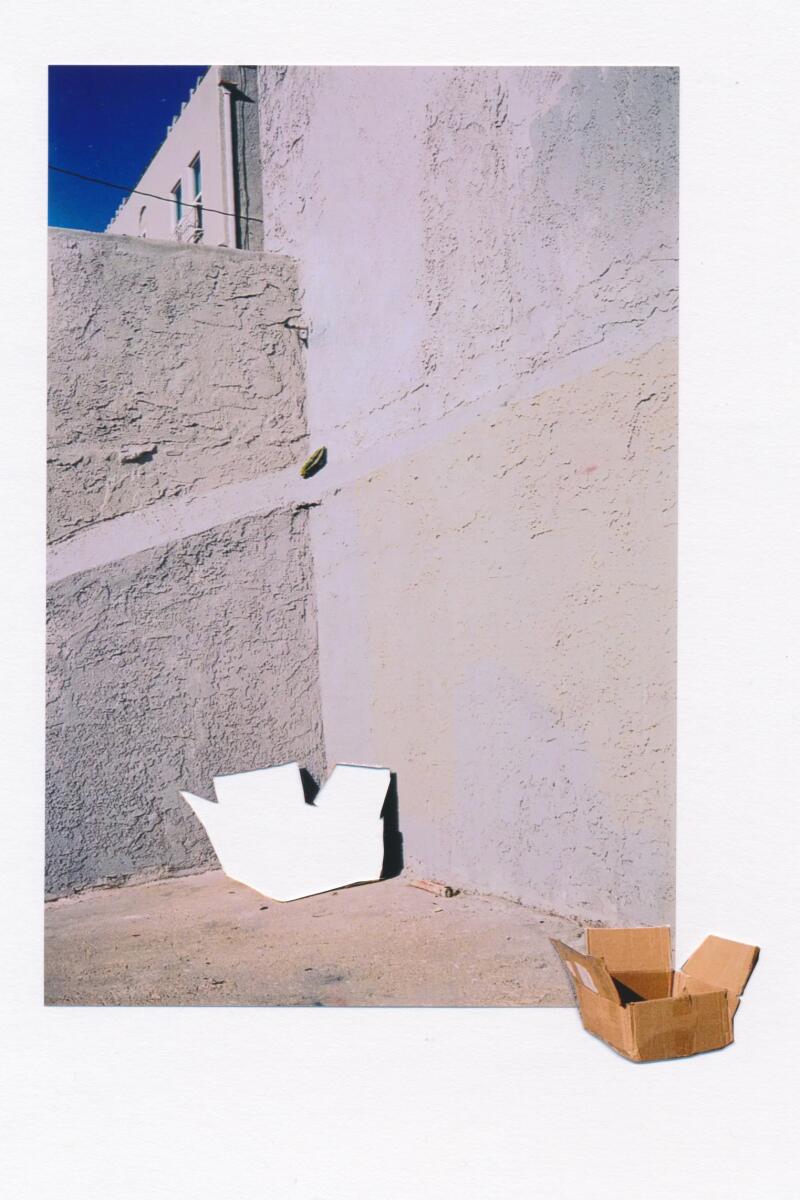
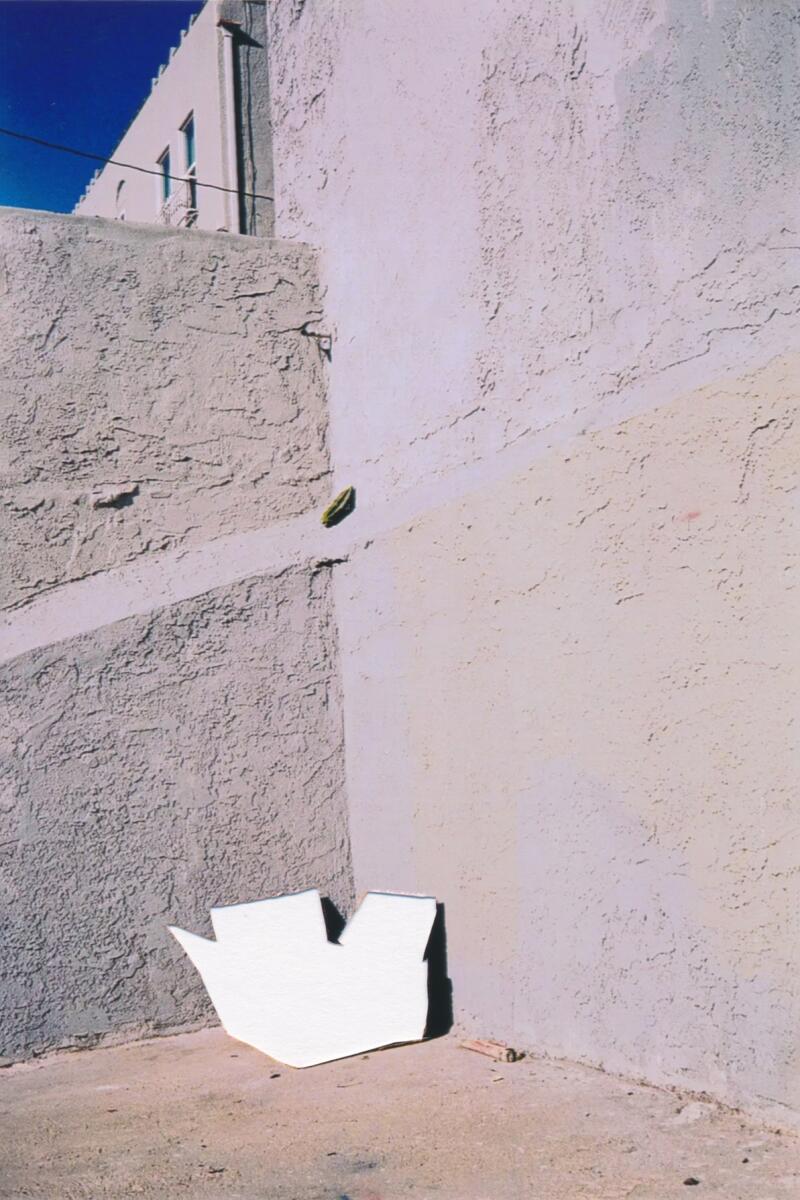
Los Angeles has been a haven for transplants and immigrants since the tail end of the Industrial Revolution and the introduction of the railroad. It was once advertised as a wellness paradise, the sanatorium capital of America, a temporary resort for turn-of-the-20th century tuberculosis patients eager to seek treatment in the form of sunshine and “fresh” air. Many of these patients got better and stayed. “Los Angeles, it should be understood, is not a mere city. On the contrary, it is, and has been since 1888, a commodity; something to be advertised and sold to the people of the United States like automobiles, cigarettes, and mouthwash,” writes Mike Davis in “City of Quartz.”
The commodification of Los Angeles and Hollywood, and the rising population, has made the city an expensive place to live. The majority of the population rents: According to a 2021 report, 63% of Los Angeles households are renter-occupied, while 37% are owner-occupied. And rent has more than doubled in the past decade, leading to an astonishing 57% of L.A. County residents being rent-burdened, meaning they spend a third or more of their income on rent. And yet people continue to move to Los Angeles, a place synonymous with liminal space — the space between who we are and who we want to become. Even if who you want to become is out of reach.
“If there is a predominant feeling in the city-state [Los Angeles], it is not loneliness or daze, but an uneasy temporariness, a sense of life’s impermanence: the tension of anticipation while so much quivers on the line,” writes Rosecrans Baldwin in “Everything Now: Lessons From the City-State of Los Angeles.”
Los Angeles is a city always on the edge of disaster: gentrification, housing shortages, unlawful evictions, homelessness (second largest homeless population outside of New York), greed, wildfire, earthquakes, floods, landslides, the imminent death of the legendary palm trees, the intangible but plausible possibility of breaking off from the continental United States and slipping into the Pacific Ocean. The city, like its residents, is impermanent, always shape-shifting, always on the verge of becoming something else.
“Our dwellings were designed for transience,” writes Kate Braverman about the midcentury West Los Angeles of her childhood in “Frantic Transmissions to and From Los Angeles: An Accidental Memoir.” “Apartments without dining rooms, as if anticipating a future where families disintegrated, compulsively dieted, or ate alone, in front of televisions.”
In Westwood, our living room was our dining room and our office. Leases were signed on the dinner table. At any moment, the phone or doorbell would ring with someone dropping off a rent check or complaining about a broken air conditioner or standing barefoot in a bathrobe locked out of their apartment. I would pretend to not care. I would eat my cheese puffs on the couch and stare attentively at the glowing TV, with the business of the building in my periphery. I would remind myself that this was temporary. Our liminal space. Maybe my parents would invest in an adult day care center like their friend Sasha? Maybe we would one day own a house? As I got older, I grew more ashamed. More aware of my own body and its presence. I would cower in my room or the hallway, shoveling Froot Loops into my mouth until the apartment was no longer an office but our home again. This shape-shifting was its own type of impermanence. One minute the apartment was a place where we lived and the next it was a place where we worked. The line was blurred and so was my idea of home. Of what is yours and what is mine.

Some of the tenants were there before us and some were a rotating cast of characters. But all of them were strangers we shared walls with. Of course, we weren’t the only immigrant family. There were also Persian immigrants who fled Iran during the Islamic Revolution, but they mostly kept to themselves. Due to the nature of the job, we were always on display. My parents’ accents. My growing body. My father’s health. The mezuzah on our door frame. Our apartment, a collection of discarded furniture from vacated units. Early on, I was warned to not make friends with any of the tenants. I was told it was unprofessional. A trap. That they only wanted to be my friend so they could get special treatment. Sometimes, we broke the rules. I babysat the child star while his single mother “networked” (partied in the Hollywood Hills). I played Marco Polo in the pool with the Persian kids. I leafed through headshots with a Russian mail-order bride while my parents drank tea with her mother. They would all eventually move out and so would we.
I used to tell my friends that we owned the building. That I would one day inherit it. This was easier than saying that we lived there because we worked there. I’m not sure if anyone believed me anyway. Many of my friends lived in what I considered to be mansions with nannies and parents with six-figure dual incomes that afforded them trips to faraway destinations I couldn’t place on a map. When my friends were over and the landline would ring, I would rush them to my bedroom before they could hear my father answer the phone with, “Manager.”
The only property my parents own is a shared plot at Hollywood Forever Cemetery. When my father was diagnosed with a chronic disease, my mother was left to manage the Westwood building on her own. Eventually, my parents retired after 21 years and moved out of the building during the first few months of the pandemic. They still rent, and so do I.
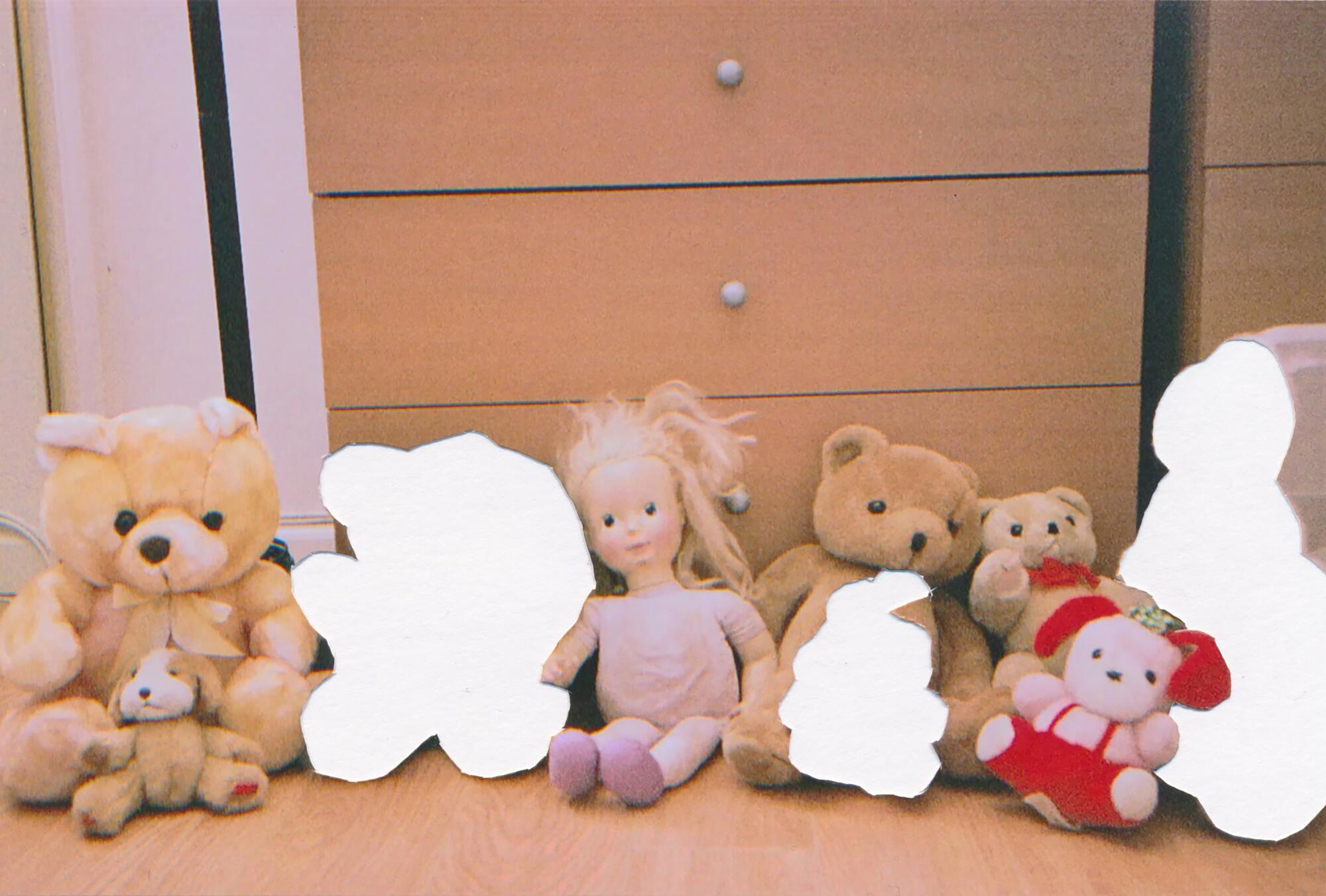
What is truly ours?
I’ve spent my life grappling with the concept of ownership. How our identity often gets wrapped up in what we own and what we don’t own. How in the U.S., ownership is the pinnacle of success. How there was no such thing as ownership in the failed Soviet experiment. How you could pick apples off any tree because they were there for everybody to enjoy. How owning a home in Los Angeles may forever be out of reach. How impermanent we are in the arbitrary nature of existence.
After I graduated from college and landed an office job in Los Angeles, I began renting apartments on my own. The eggshell walls painted over and over and over again. The rotating neighbors I still feared to befriend. The flying cockroaches. The broken laundry machines. The unabiding footsteps. The eternal sounds of other people’s lives. The possibility of moving out and starting all over again. It all felt so familiar. The impermanence I witnessed so often as a child was no longer a source of shame but a knowing comfort that at any moment everything could change.
Diana Ruzova is a writer from Los Angeles. She holds an MFA in literature and creative nonfiction from the Bennington Writing Seminars. Her writing has appeared in the Cut, Oprah Daily, Flaunt, Hyperallergic, Los Angeles Review of Books and elsewhere.
-

 News1 week ago
News1 week agoSkeletal remains found almost 40 years ago identified as woman who disappeared in 1968
-

 World1 week ago
World1 week agoIndia Lok Sabha election 2024 Phase 4: Who votes and what’s at stake?
-

 Politics1 week ago
Politics1 week agoTales from the trail: The blue states Trump eyes to turn red in November
-

 World1 week ago
World1 week agoBorrell: Spain, Ireland and others could recognise Palestine on 21 May
-

 World1 week ago
World1 week agoCatalans vote in crucial regional election for the separatist movement
-

 Politics1 week ago
Politics1 week agoNorth Dakota gov, former presidential candidate Doug Burgum front and center at Trump New Jersey rally
-

 Movie Reviews1 week ago
Movie Reviews1 week ago“Kingdom of the Planet of the Apes”: Disney's New Kingdom is Far From Magical (Movie Review)
-

 World1 week ago
World1 week agoUkraine’s military chief admits ‘difficult situation’ in Kharkiv region
/cdn.vox-cdn.com/uploads/chorus_asset/file/23249791/VRG_ILLO_STK001_carlo_cadenas_cybersecurity_virus.jpg)



